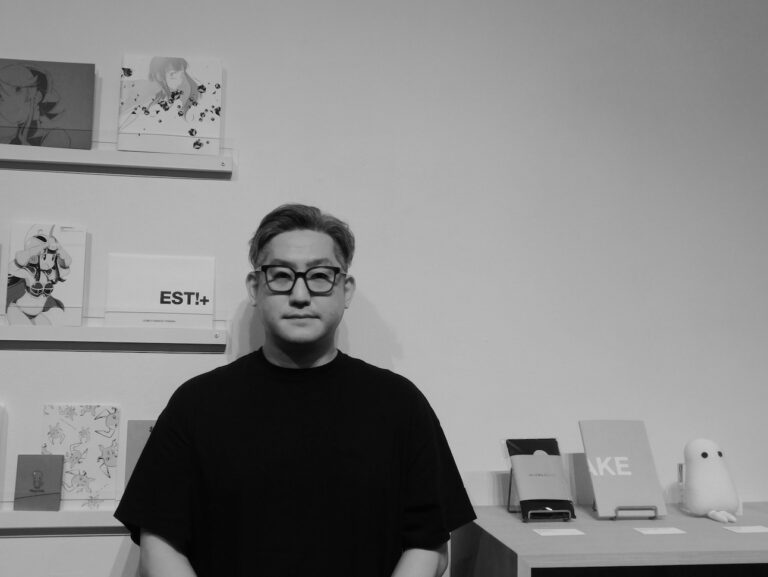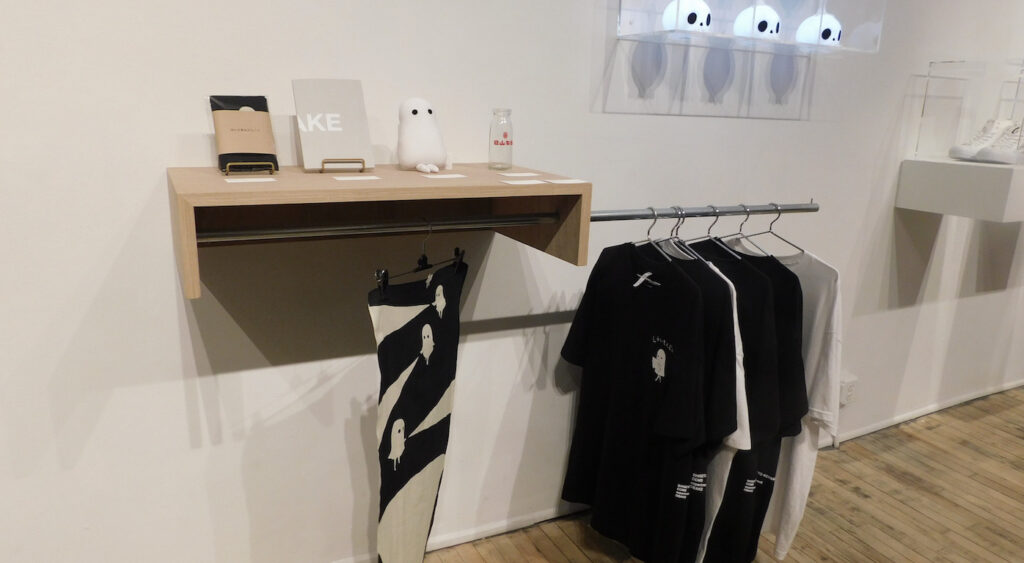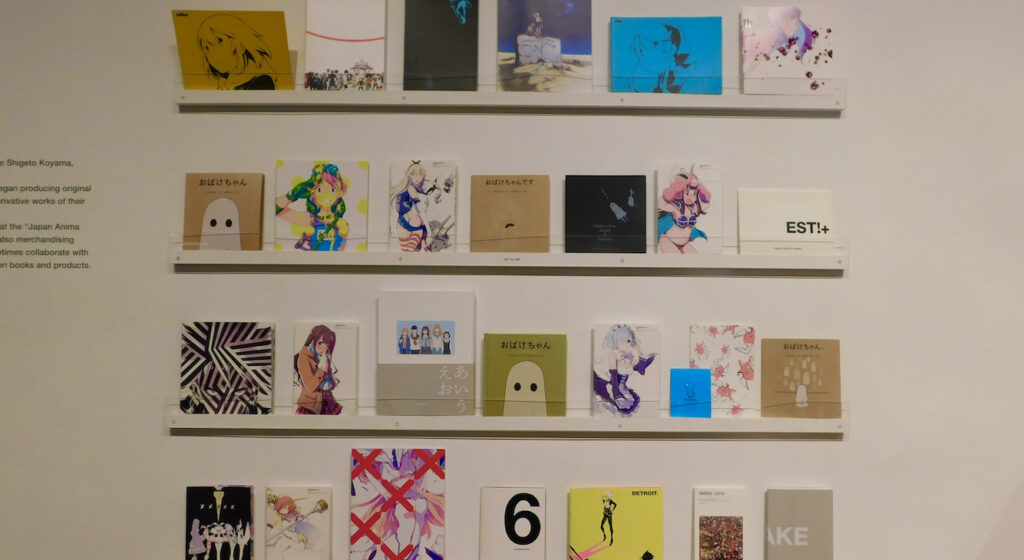
Recently, I had a chance to sit down with one of the most well known and prolific illustrators and mecha designers in Japan, Shigeto Koyama. His professional career spans from the “Evangelion” movies, “Promare,” “Kill la Kill,” “Gurren Lagann,” “Star Wars : Visions” and Disney’s “Big Hero 6.” This time, he brought his comprehensive “experiment” in New York, which is called, “SHIGETO KOYAMA CCMS experiment OBAKE,” Koyama channeling his idea into a lively spot of animation in downtown NYC’s NowHere gallery.

Exclusive Interview with Art Director/Illustrator/Character Designer/Mechanical Sesigner Shigeto Koyama
Q: Koyama-san, your parents worked at Shiseido and you initially wanted to become a product designer for a while. But in 1998, you formed the independent video unit “Kokujin (Negro) Computer” with Daisuke Nishijima. What was your motivation that got you to this point?
Shigeto Koyama: Well, the biggest thing happened to me was when I watched the animated version of “Neon Genesis Evangelion” directed by Hideaki Anno from 1995 to 1996, and in 1997, “Neon Genesis Evangelion: Death & Rebirth,” and “Neon Genesis Evangelion: The End of Evangelion.” These movies were released in Japan for the first time in Spring and Summer.
That was so impactful for me that I felt I had to do something to convey my feelings. I decided to make an “Eva” Coterie magazine. But we were not used to making books, but Daisuke Nishijima and I were discussing what we could do, and since he could use a Macintosh, we thought we could do something with video. So we decided to make an independent film, staying at Nishijima’s house. So it all started as a love letter to “Neon Genesis Evangelion,” in a way active as a fan.
Q: After that, you established a company called “Undersell ltd.” with Daisuke Nishijima, Gichi Otsuka, Ryo Kikuzaki, and Shotaro Miya. What were your main activities there?
Shigeto Koyama: “Undersell ltd.” is a rather complicated company. We did some video projects and produced books, but my initial job at the time was as an illustrator. I also did radio work and various types of other jobs. My work at that time was cover art for a book on display here by Yoshiyuki Tomino — the director of “Mobile Suit Gundam.” Usually, people who draw pictures don’t do book design but the company made me do all kinds of work like that.
I had a lot of experience in radio, TV, film, books, and games. Even though I created and drew characters, illustrations do not speak or move. In order for the audience to understand the characters, I thought it was necessary to tell a story about them. I started drawing manga because I needed to be able to create a story.
Q: Did you have a favorite manga at the time?
Shigeto Koyama: I’ve liked Osamu Tezuka since I was a child. I also liked Mamoru Nagano’s manga “Five Star Stories.” I read a lot of manga growing up, but when it came time to draw them myself, I was not satisfied [with my work] because I loved manga so much. I despaired that I could not draw manga at that time. Around that time, Yoshiyuki Sadamoto, the character designer for “Neon Genesis Evangelion,” happened to ask me, “Koyama-kun, why don’t you try your hand at animation?” I said, “Let me do it,” and I entered the world of animation.

Q: Around that time, in the mid ‘90s, “Neon Genesis Evangelion” was a social phenomenon. Given that these existing works had already become huge hits, you had to create something new. For you to work with Sadamoto, what was your position in that context?
Shigeto Koyama: The studio I joined was called Gainax, the company that made “Neon Genesis Evangelion.” The creators in the studio were all very good at drawing and were at the top [of their game]. I had a huge complex and since it was my first experience, I felt I wasn’t good enough to be among them.
But I had a lot of guts, and when I asked the studio to let me work, they gave me a lot of chances even though I was a newcomer. There was a director named Kazuya Tsurumaki who worked on the “Evangelion: 1.0 You Are (Not) Alone” in 2007.
He had seen my work at “Undersell ltd. He was like, “Koyama-kun, “You can do this kind of thing, can’t you?” I tried my hand at writing scripts, design, character costumes, mechanical design, and various other things. As I got more and more involved, I thought there might be a place for me.
Q: Is that similar to the illustrations done for “Monster Hunter?”
Shigeto Koyama: “Monster Hunter” was a part of Undersell ltd.’s work. At that time, when I was illustrating “Monster Hunter,” it was not yet such a popular game. When the first one came out, it was still difficult to connect it to online, and the Internet was not that popular yet. But there were still quite a few users back then. I was told that there was a challenging game called “Monster Hunter,” and I was told to do the illustrations. After I illustrated the game, it suddenly became a huge hit. I think that experience has been a great source of inspiration for my later work in the world of animation.
Q: You are also involved in Hideaki Anno’s new film — “Shin Kamen Rider.” How big a presence was Mr. Anno for you?
Shigeto Koyama: The reason I started making films was because of Anno’s movies, so I have tremendous respect for him.
Q: Now there’s the “SHIGETO KOYAMA CCMS experiment OBAKE” — an exhibition of animation for creators presented by Sony Music. The “OBAKE-chan” you worked on this time is a setting in which these characters are training to become full-fledged ghosts, and people in America are going to love it.
Shigeto Koyama: There are quite a few different contexts for “Obake-chan. Dick Bruna, the artist who draws the rabbit character Miffy, based it on the original Dutch name, “nijntje.” He was originally a book and book binding designer.
But he wrote a picture book and created the rabbit character to show to his daughter and grandchildren. In being a designer, you take orders. But writing a picture book is quite a creative process, and since we had the context of having done such a thing, we decided to make a picture book too.
We thought about how to do it, and came up with the idea of making copies of a European doll called the Playmobil. In the Playmobil, there was a “ghost” covered by a cloth, and we realized that this was the image of a ghost that the whole world could understand.
We created our own character called “Obake-chan,” a Ghost Girl. Usually, “Ghosts” are dead, but as characters, they’re alive, so we had a powerful notion of combining such opposites into one character.


